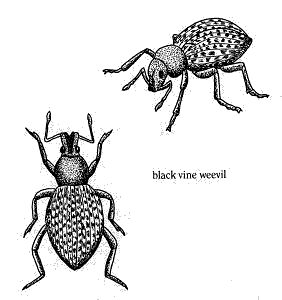 |
Weevils are a whole family of small beetles. Most of the common pest weevils are brown or black and tear-shaped. They have hard-shelled bodies and long snouts. They feed at night and hide in the soil during the day.
The black vine weevil is sometimes called the taxus weevil and also attacks broad-leaved evergreens such as azalea and rhododendron. The larvae are small whitish grubs, which feed within the fruit, stem, or roots of plants. Eggs are typically laid on susceptible plants, or even injected into them. Winter may be passed as an adult or grub. Often, many generations occur a year.
The insect overwinters outdoors as a soil inhabiting larva. The adults may over-winter in homes or a similarly sheltered spot. The over-wintering larvae pupate in early June. The adults emerge from the soil in mid-June and begin to lay eggs near the end of June. The eggs are laid at the base of the plant and hatch within two weeks and the larvae burrow into the soil. The larvae feed on the roots
The adults are black, hard- shelled insects with a long snout. The back appears to be ridged or grooved. The adults are white, legless grubs. The adults are shy and hide near the soil during the day.
Both adults and grubs injure plants but that caused by grubs is most serious. The larvae feed on the roots and stems. The feeding can girdle the stem, killing the plant.
Symptoms of Weevil Attack
The adults feed on the foliage causing it to have a notched appearance. Early in the infestation the injury may be confined to interior and less obvious foliage. Larvae and adults may feed on leaves and fruit. Larvae make zigzag paths into roots, fruit, or stems.

